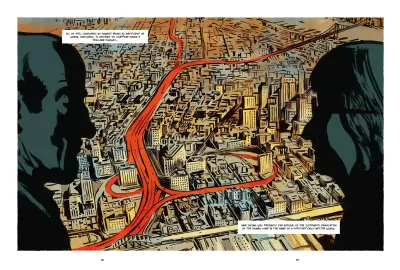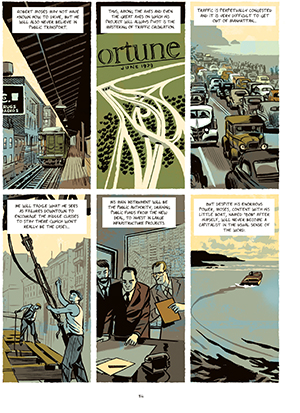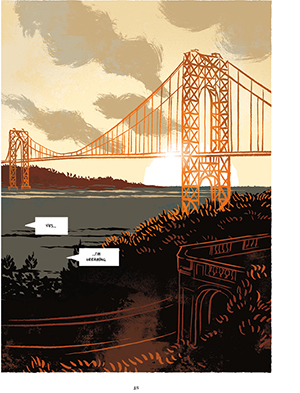Graphic novel retells the story of America’s greatest dictator-planner.

On the two most towering figures in 20th century American urbanism, arch rivals Robert Moses and Jane Jacobs, plenty of words have been written. Jacobs' were mostly by her own hand. Moses, the more monumental if enigmatic figure, was too busy building to do much writing. His legacy belongs largely to Robert Caro, who wrote 1,344 pages about him.
![]() Does the world need yet another account of Moses' crusade to build the 20th century's greatest city (and Jacobs' efforts to save its soul)? It does, perhaps, when that book is Pierre Christin’s and Oliver Balez’s engaging, unexpected graphic novel Robert Moses: The Master Builder of New York City.
Does the world need yet another account of Moses' crusade to build the 20th century's greatest city (and Jacobs' efforts to save its soul)? It does, perhaps, when that book is Pierre Christin’s and Oliver Balez’s engaging, unexpected graphic novel Robert Moses: The Master Builder of New York City.
If nothing else, Robert Moses was larger than life. In wresting control of city commissions and building some of the city's greatest parks, bridges, and housing projects seemingly singlehandedly, he could almost be considered a superhero. Or supervillan, depending your point of view. As a close cousin of the comic book, the graphic novel is well suited to illustrate, literally, Moses' powers.
With the exception of a few flash forwards, Robert Moses traces his life from childhood to lonely sunset. Young Robert had more than a few chips on his shoulder, and more than a few lessons to learn, as the scion of a wealthy Jewish family. He witnessed the depredation of Manhattan's tenements and suffered the taunts of anti-Semites, particularly at Yale. He learned to revile the era's robber barons and pity the city's poor.
Out of college, Moses meets his future wife, to whom he is not, the story suggests, always faithful, and he meets Mrs. Moskovitz, a wealthy, well connected matron who launches Moses' political career. In short order, Moses distinguishes himself in the Gov. Alfred E. Smith administration, dreams of building New York City, and gets himself appointed head of the state-administered Parks Commission. The rest is (well documented) history: fueled by a seemingly psychotic desire to build and buoyed by supreme confidence, Moses served in executive positions, sometimes in 12 simultaneously, from 1924 to 1968.
 Naturally, Robert Moses does not claim to be an historical document. Caro already did that heavy lifting. The book is, however, a human portrait of a hardened man and a stirring rendering of his works. Needless to say, a picture book suits tales of urban planning well. We see the Maritime Theater, the George Washington Bridge, the Cross-Bronx Expressway, and the United Nations headquarters—among dozens of his other projects reverently rendered. We see them rise as the cartoon Moses himself looks on with self-pride. We see pathos as he overlooks the scale model of New York that he commissioned for the unsuccessful 1963 World's Fair.
Naturally, Robert Moses does not claim to be an historical document. Caro already did that heavy lifting. The book is, however, a human portrait of a hardened man and a stirring rendering of his works. Needless to say, a picture book suits tales of urban planning well. We see the Maritime Theater, the George Washington Bridge, the Cross-Bronx Expressway, and the United Nations headquarters—among dozens of his other projects reverently rendered. We see them rise as the cartoon Moses himself looks on with self-pride. We see pathos as he overlooks the scale model of New York that he commissioned for the unsuccessful 1963 World's Fair.
It's an odd feeling to see a historical figure represented visually, with his carriage, mannerisms, and emotions on display, often, in Moses’ case, with a beatific look of self-satisfaction. Moses is routinely portrayed as an imposing figure, looming over his colleagues and issuing orders never to be disobeyed. That much is believable, given what Moses accomplished. More troublesome is the dialog. Much of it is didactic, with Moses giving tours of the city to explain what he’s building. Some of it is romantic, as when he's flirting with showgirls.
At one point, Moses is compared explicitly to Batman. It's a jarring, campy moment. Then again, Moses could do worse. Batman is the most complex figure in the Justice League, and the most urban.
 And what could be better suited to a graphic novel than images of a city? Balez, the illustrator, renders New York in an appealing palette of browns, ochres, grays, and tans, punctuated by blazes of deep orange. Meanwhile, fashions evolve along with Moses' career, right up to the point whenhis passers-by appropriately look like extras from Mad Men, heading to Moses' Lincoln Center after a long day at Sterling Cooper, and then over his Triborough Bridge (whosetolls funded much of his work) to their homes near Rockaway Park, which Moses developed.
And what could be better suited to a graphic novel than images of a city? Balez, the illustrator, renders New York in an appealing palette of browns, ochres, grays, and tans, punctuated by blazes of deep orange. Meanwhile, fashions evolve along with Moses' career, right up to the point whenhis passers-by appropriately look like extras from Mad Men, heading to Moses' Lincoln Center after a long day at Sterling Cooper, and then over his Triborough Bridge (whosetolls funded much of his work) to their homes near Rockaway Park, which Moses developed.
In its most joyous sequence, we meet Jane Jacobs for the first time. She is, in a quartet of panels, riding a bicycle through various scenes of classic New York. In each, she is in the same position, facing the same direction, with the same beatific expression on her face. The human-scale ballet of the city takes place around her. She appreciates it in ways that the Master Builder never could. She takes on Moses over the proposed Lower Manhattan Expressway and the extension of Fifth Avenue. We know how those battles turned out.
But those defeats led to a cascade of rebukes and demotions as Moses finally proved vulnerable and politicians caught on to other ideas. New York may have been Moses' city for most of the 20th century. These days, though, we are living in Jane Jacobs' world. In the end, the pictures and speech bubbles of Robert Moses ask, who is the real hero: the builder, or the writer?
Robert Moses: The Master Builder of New York City
Pierre Christin and Olivier Balez
Nobrow, Ltd.
112 pages
$24.95

Maui's Vacation Rental Debate Turns Ugly
Verbal attacks, misinformation campaigns and fistfights plague a high-stakes debate to convert thousands of vacation rentals into long-term housing.

Planetizen Federal Action Tracker
A weekly monitor of how Trump’s orders and actions are impacting planners and planning in America.

In Urban Planning, AI Prompting Could be the New Design Thinking
Creativity has long been key to great urban design. What if we see AI as our new creative partner?

Car Designs Make it Harder to See Pedestrians
Blind spots created by thicker pillars built to withstand rollover crashes are creating dangerous conditions for people outside vehicles.

Cal Fire Chatbot Fails to Answer Basic Questions
An AI chatbot designed to provide information about wildfires can’t answer questions about evacuation orders, among other problems.

What Happens if Trump Kills Section 8?
The Trump admin aims to slash federal rental aid by nearly half and shift distribution to states. Experts warn this could spike homelessness and destabilize communities nationwide.
Urban Design for Planners 1: Software Tools
This six-course series explores essential urban design concepts using open source software and equips planners with the tools they need to participate fully in the urban design process.
Planning for Universal Design
Learn the tools for implementing Universal Design in planning regulations.
Appalachian Highlands Housing Partners
Gallatin County Department of Planning & Community Development
Heyer Gruel & Associates PA
Mpact (founded as Rail~Volution)
City of Camden Redevelopment Agency
City of Astoria
City of Portland
City of Laramie


























